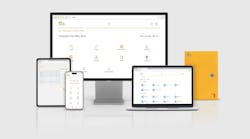There’s an old industry adage that physical security begins with access control. And for good reason; after all, if you can’t control who is entering your facility all of your other security measures become superfluous.
However, the need for unflinching standards in access control reliability has also meant that the market has been slower to evolve than many other product segments in the industry. While video surveillance vendors, for example, have been eager to migrate to mobile and cloud-based solutions, access control providers have, for the most part, been much slower to adopt cutting-edge technologies. As a result, many modern access control deployments still employ legacy products and technology architectures.
This is changing, however, as a growing number of companies with mobile and cloud-first technologies have introduced a paradigm shift to the industry. One company looking to carve out its own niche in the market is Nexkey. Making its debut appearance at ISC West this year, Nexkey, which was recognized with a 2019 SIA New Product Showcase Award in the wireless access control devices and peripherals category, offers a smart access control platform managed via the cloud that enables end-users to use their smartphones as their primary credential.
SecurityInfoWatch.com sat down with Eric Trabold, CEO of Nexkey, to discuss what differentiates their product from other offerings on the market and their plans to grow the company moving forward in this first-time exhibitor Q&A:
SIW: What differentiates your access control technology from other offerings on the market?
Trabold: One thing that stood out to me when I did my research on the access control market – even before joining Nexkey – is that when I wanted to install it, it always seemed expensive to me. At my last company, I called some local companies and they told me that to outfit the front door of our office that it would be around $2,500 to $3,000 to get started. Access control felt expensive, specifically for small- to medium-sized businesses. It also didn’t feel like a good solution to have something you have to carry around with you like a key card or fob and it also didn’t feel very secure because you could lose it out in the hallway and somebody could pick it up and just enter the office with it.
With Nexkey, we provide a more affordable solution that has a better user experience to a broader market. The key problem that we eliminate to help save cost is the conflict of installation. When I look at most access control solutions out there, they have electric door hardware – a reader that’s connected to a door controller that gets wired up to an access control panel. There’s just a lot involved to get access control going. What we built with our Nexkey Core and Controller is a product that basically integrates everything you have from the door hardware to the controller to the panel in one hardware product which makes the installation significantly faster and allows us then to offer the product way cheaper to our customers.
SIW: What’s your go-to-market strategy?
Trabold: Our initial strategy was that we wanted to sell direct for both business reasons as well as for us internally to learn more about the customer and how they perceive the product. Last August, we launched our website to reach out to the world, we started to advertise online and people came to Nexkey. This meant a lot to us in terms of actually understanding how they use the platform and where we still have to enhance the platform. It also helped us engage with installation partners, mainly locksmiths and smaller systems integrators in California, and we tagged along with them on installations of our product to also learn where we have to optimize from that perspective.
Now, the next step we want to take at ISC West is to let potential partners out there know that Nexkey exists and we’re going to start building a partner program to get the product basically into different channels. That will ideally allow us to go up to larger clients because right now I would describe our client base as small and medium-sized businesses – imagine businesses with 15 to 300 employees or tenants – and we feel partners can help us deploy Nexkey at a greater scale.
SIW: What do you see as being the sweet spot in the market for your platform?
Trabold: We have a large number of co-working spaces as clients because they have a specific pain point. Imagine a co-working space where you have 300 tenants and each of them are different every month but then also managing access with key cards or fobs is a lot work because they have to reprogram the cards, get them back from members, etc. and they love the idea of the mobile app or web portal and being able to go in and change user credentials. Or, even better, we have a public API on the mobile SDK and they can integrate it into their workflows. Let’s say they have a meeting room management system and you tie that into the Nexkey API and when somebody books the meeting room, they can get access immediately.
Another vertical where we provide a lot of value is gyms, not for the members but for the staff. Instead of their employees having to carry around key cards and fobs across a whole bunch of different locations, they can enter all those locations with their mobile phones and the managers of those spaces can actually see that the staff showed up on time. Then there are other verticals that have reached out to us that we wouldn’t really have expected where there is a need for what we have like churches, quite a few of them actually.
SIW: What do believe have been some of the biggest shortcomings of mobile and cloud access technologies historically?
Trabold: A couple of things happened in the market from a technology perspective that makes it feel like it’s the right time to really allow people to manage access on a mobile device. One is, I think specifically over the last five years, smartphone adoption grew quite a lot and still are, and so five years ago you probably would’ve had a lot more pushback from businesses that would have said, “You know what, not all of our employees actually have a smartphone.” But now that has really shifted because people are saying, “Why can’t I open my door with my phone?” In reality, I can already pay you with my phone, so someone is already working on eliminating the wallet, but why am I still carrying this keychain around with all these fobs and key cards.
And then there is the pricing aspect and ease of deployment, which was something that was holding the industry back. One thing that I’ve seen as well, when I looked at different apps and web portals used to manage web-based systems… they look really, really complex and I don’t know if we’ve made it easy for administrators to manage access control. From the beginning we’ve focused on the user experience and making granting and revoking access, and having an audit trail as easy as possible to understand.
About the Author:
Joel Griffin is the Editor of SecurityInfoWatch.com and a veteran security journalist. You can reach him at [email protected].


